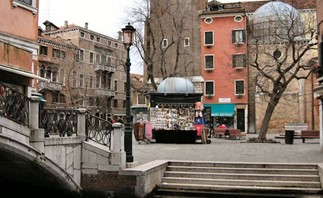Here we are in Campo Santi Apostoli, with the church of the Saint Apostles in the middle.
Looking towards the small canal, you’ll see a beautiful gothic house above the bridge. This was home to the Doge Marino Falier, an infamous figure in Venetian history. He once held a ball here, and among the participants was a young man who, rather drunk, began to importune one of the house-maids and so was asked to leave; which he did, but not before leaving a note implicitly calling Falier’s wife a harlot. The young man, who would later become doge himself, was fined, whipped and sent to prison; Falier complained to the Judiciary Council that the punishment was not adequate enough but no avail, and so, beyond himself, plotted to seize complete control of the state. His scheme was uncovered and he was immediately decapitated in public. It’s important to note that the doge’s figure was symbolic more than anything, as Venice was first and foremost a city where individual pride had no place, tyrannyical aspirations were unfeasible, and power was synonymous with the city, not a person.






